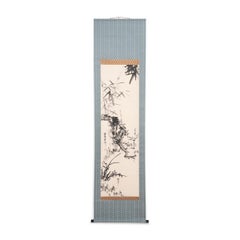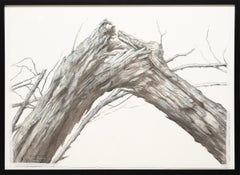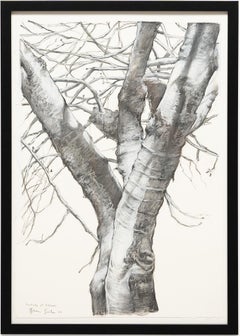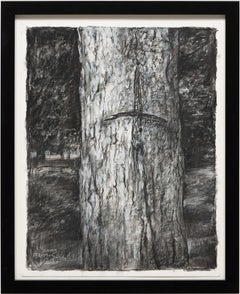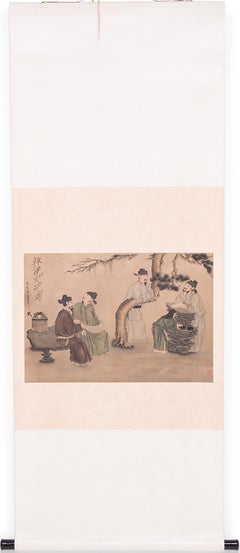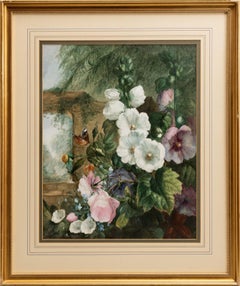PAGODA RED Landscape Drawings and Watercolors
to
1
1
1
4
Overall Width
to
Overall Height
to
1
3
3
6
1
2
2
2
2
2
1
1
1
1
1
1
1
1
1
1
7
4
3
3
3
3
3
7
Korean Hanging Scroll of Bamboo, Prunus, and Orchids
Located in Chicago, IL
This Korean hanging scroll from the mid-20th century honors traditional calligraphy painting with delicate detail and a refined composition, thought to inspire clear and concise thinking. Expressing the beauty and resilience of nature’s flora, ink calligraphy artists traditionally select plants and flowers as the subjects of their works, each chosen for its auspicious meaning, literary resonance, or scholarly virtue.
This particular example depicts a quiet natural landscape of three plants growing side-by-side along a rocky hill. Strong bamboo stalks sway above a branch of delicate prunus branches, while elegant orchids blossom in the foreground. Each painted by a different artist, these sacred plants represent the cycle of the seasons: the plum blossom for winter, the orchid for spring, and the bamboo for summer. Brushed with black ink for a monochromatic expression, the painting relies on value rather than color to convey depth and texture within this simple setting. The collaborative painting is contrasted by a beautiful blue silk brocade border woven with a repeating pattern of blossoms and vines.
Each plant is signed individually in ink along with the artist’s seal.
Painting has been remounted. Includes a wooden scroll...
Category
Mid-20th Century Folk Art Landscape Drawings and Watercolors
Materials
Silk, Paper, Ink
"Broken Spirit, " Charcoal on Paper
By Bruno Surdo
Located in Chicago, IL
Chicago-based fine art painter Bruno A. Surdo is classically trained in drawing and oil painting in the tradition of Renaissance masters. With strong command of the human form, Surdo...
Category
21st Century and Contemporary Naturalistic Figurative Drawings and Water...
Materials
Charcoal, Paper
"Memory of Leaves, " Charcoal on Paper
By Bruno Surdo
Located in Chicago, IL
Chicago-based fine art painter Bruno A. Surdo is classically trained in drawing and oil painting in the tradition of Renaissance masters. With strong command of the human form, Surdo creates dynamic compositions of people and places that communicate a rich commentary on the world around him. Depicting trees from personal encounters, Surdo’s latest body of work entitled “Tree Spirits” takes us on a foray into the forest, where leaves, branches and burls express something deeply personal. Applying his mastery of figurative realism to the natural world, he experiments with form and texture to uncover the intangible spirits of trees.
This charcoal drawing entitled “Memory of Leaves” beautifully illustrates the branching form of a mature birch tree. Loosely drawn with informal, sketch-like linework, the tree is shown in the middle of winter, bare of leaves and white with frost. Surdo’s skillful placement of shadow illustrates the forking branches with incredible texture and effortless realism. The intricate play of light and dark is accentuated by the stark white background, a negative space that isolates the tree in space and time.
Restricting the composition to only a portion of the tree trunk, Surdo accentuates the tree’s abstract form, lingering on areas of unusual shape or texture. Seeking to convey the strong emotional response elicited by his initial encounter with the tree, Surdo focuses on the tree’s sculptural form, contrasting the strong trunk...
Category
21st Century and Contemporary Naturalistic Still-life Drawings and Water...
Materials
Paper, Charcoal
"Faith, " Charcoal on Paper, 2023
By Bruno Surdo
Located in Chicago, IL
Chicago-based fine art painter Bruno A. Surdo is classically trained in drawing and oil painting in the tradition of Renaissance masters. With strong command of the human form, Surdo creates dynamic compositions of people and places that communicate a rich commentary on the world around him. Depicting trees from personal encounters, Surdo’s latest body of work entitled “Tree Spirits” takes us on a foray into the forest, where leaves, branches and burls express something deeply personal. Applying his mastery of figurative realism to the natural world, he experiments with form and texture to uncover the intangible spirits of trees.
Entitled “Faith,” this small-scale charcoal drawing depicts a tree trunk carved with two deep cuts in the shape of a cross. The carving has healed over, assimilated into the bark as just another interesting detail. Up close, the work is loosely drawn with a heavy hand, but from afar, the natural scene still achieves a sense of realism. The tree trunk is conveyed through chaotic scribbling and aggressive strokes of light and dark charcoal, resulting in a pattern that simulates the rough texture of bark. Light falls softly on the tree, illuminating its form against the dark, atmospheric surroundings.
The striking imagery of this work conveys the strong emotional response elicited by Surdo’s personal encounter with this tree. Restricting the composition to only the scarred portion of the tree trunk, Surdo focuses on symbolism of the cross carved into the tree’s side. The carving was inflicted upon the tree by an individual, whether as an act of graffiti or the object of adoration. Despite this wound, the tree persists and grows, adapting and changing until the mark is but another interesting detail. The tree’s spirit endures and speaks to the strength it takes to heal oneself, whether physically or mentally.
Charcoal on paper...
Category
21st Century and Contemporary Naturalistic Landscape Drawings and Waterc...
Materials
Paper, Charcoal
"Literary Garden, " Chinese Scroll Painting
Located in Chicago, IL
Exquisitely painted with delicate line work and a subdued color palette, this Chinese scroll painting is an early 20th century reproduction of a famous...
Category
Early 20th Century Qing Figurative Drawings and Watercolors
Materials
Silk, Paper, Ink
Japanese Riverside Landscape Scroll, c. 1900
Located in Chicago, IL
Although Western painting was initially embraced during Japan’s Meiji period (1868–1912), artists brought on a revival of traditional painting styles as they sought to create a moder...
Category
Early 20th Century Landscape Drawings and Watercolors
Materials
Silk, Paper, Ink
"Hanging Scroll of Prunus Branches, " Ink on Paper
Located in Chicago, IL
Chinese scholars used natural imagery and scenery to aid in contemplation within the walls of their studios. The complex beauty inherent to landscapes and natural forms inspired clea...
Category
19th Century Qing Figurative Drawings and Watercolors
Materials
Paper, Ink
Related Items
Hollyhocks and Roses in a Garden with Butterfly
Located in Stockholm, SE
This is a beautiful and highly decorative watercolor painting, featuring a charming garden scene filled with pink and white hollyhocks alongside blooming roses. Nestled among the del...
Category
Late 19th Century Naturalistic Still-life Drawings and Watercolors
Materials
Paper, Watercolor
$1,535
H 31.11 in W 26.38 in D 1.19 in
Landscape by Moonlight, Waterfall, Monthelier, French Romantic Art, Christmas
Located in Greven, DE
Fine Watercolour Drawing by Alexandre Jules Monthelier. He was a French Artist who worked in France and created many drawings of famous landscape and sceneries (e.g. the cathedral of...
Category
19th Century Romantic Landscape Drawings and Watercolors
Materials
Watercolor, Handmade Paper
Glastonbury Abbey
By Frederick Nash
Located in Middletown, NY
Ink wash with watercolor in sepia and black, and blue, on buff wove watercolor paper, 14 1/4 x 10 1/4 inches (360 x 260 mm). 1/4" of the lower right corner is lost, minor crack (doe...
Category
Mid-19th Century English School Landscape Drawings and Watercolors
Materials
Ink, Watercolor, Handmade Paper
Secret Garden 18 - Contemporary, Drawing, Flower, White, Black, Figurative
By Alina Aldea
Located in Baden-Baden, DE
Secret Garden 18, 2021
black ink on paper
27 9/16 H x 39 3/8 W in.
70 H x 100 W cm
The drawings signed by Alina Aldea show the meticulousness and perfection of microscopic observati...
Category
2010s Post-Modern Landscape Drawings and Watercolors
Materials
Paper, Ink
$1,130
H 27.56 in W 39.38 in D 1.19 in
1970s Abstract Seascape Acrylic Stencil Painting "Seascape"
By Edith Isaac-Rose
Located in Arp, TX
Edith Isaac-Rose
"Seascape"
1970
Acrylic stencil on paper
17"x11.5" unframed
Signed in pencil bottom left
Edith Isaac-Rose (1929-2018)
Born in Chicago in 1929, and neé Ganansky-Tei...
Category
1970s Abstract Landscape Drawings and Watercolors
Materials
Paper, Acrylic
$318 Sale Price
25% Off
H 11.5 in W 17 in
Winter Night in Canmore, black and white charcoal drawing of trees and sky
Located in New York, NY
Charcoal on paper drawing by Toronto-based artist Katherine Curci. Framed.
Katherine Curci began this series of charcoal drawings, premiered in This L...
Category
2010s Contemporary Landscape Drawings and Watercolors
Materials
Paper, Charcoal
$1,175
H 13.75 in W 17.5 in
Basilica di Santa Maria from the Grand Canal, Venice
Located in Middletown, NY
Ink and sepia wash on light wove paper, 5 1/8 x 4 inches (128 x 100 mm), signed in brown ink and dated in black ink below the image. Scattered light foxing and uniform toning. Adhered to nonarchival white cardstock, creating minor cockling, and obscuring the verso.
Alberto Prosdocimi (1852-1925) was an Italian watercolorist and celebrated mansucript illuminator known for his atmospheric cityscapes and interior views of Venice. His canal scences are simple yet masterful, filled with languid motion...
Category
Late 19th Century Italian School Landscape Drawings and Watercolors
Materials
Ink, Handmade Paper
A Grand Tour study of ruins in the Roman Forum - English School, early 19th C.
Located in Middletown, NY
Ink and wash in black ink with pen in black ink on watermarked C & I Honig cream laid paper, 14 7/8 x 12 1/4 inches (378 x 311 mm), the full sheet. In very good condition with some m...
Category
Early 19th Century French School Landscape Drawings and Watercolors
Materials
Handmade Paper, Ink
$600
H 14.89 in W 12.25 in
Whimsical Illustration Skiing Cartoon, 1938 Mt Tremblant Ski Lodge William Steig
By William Steig (b.1907)
Located in Surfside, FL
Lighthearted Illustration of Outdoor Pursuits This one being a Skiing scene, a boy and a girl on skis. signed W. Steig
Provenance: from Mrs. Joseph B. Ryan, Commissioned by Joe Ryan for the bar at his ski resort, Mount Tremblant Lodge, in 1938.
Mont Tremblant, P.Q., Canada
Watercolor and ink on illustration board, sights sizes 8 1/2 x 16 1/2 in., framed.
In 1938 Joe Ryan, described as a millionaire from Philadelphia, bushwhacked his way to the summit of Mont Tremblant and was inspired to create a world class ski resort at the site. In 1939 he opened the Mont Tremblant Lodge, which remains part of the Pedestrian Village today. This original illustration is on Whatman Illustration board. the board measures 14 X 22 inches. label from McClees Galleries, Philadelphia, on the frame backing paper.
William Steig, 1907 – 2003 was an American cartoonist, sculptor, and, in his later life, an illustrator and writer of children's books. Best known for the picture books Sylvester and the Magic Pebble, Abel's Island, and Doctor De Soto, he was also the creator of Shrek!, which inspired the film series of the same name. He was the U.S. nominee for both of the biennial, international Hans Christian Andersen Awards, as a children's book illustrator in 1982 and a writer in 1988.
Steig was born in Brooklyn, New York in 1907, and grew up in the Bronx. His parents were Polish-Jewish immigrants from Austria, both socialists. His father, Joseph Steig, was a house painter, and his mother, Laura Ebel Steig, was a seamstress who encouraged his artistic leanings. As a child, he dabbled in painting and was an avid reader of literature. Among other works, he was said to have been especially fascinated by Pinocchio.He graduated from Townsend Harris High School at 15 but never completed college, though he attended three, spending two years at City College of New York, three years at the National Academy of Design and a mere five days at the Yale School of Fine Arts before dropping out of each.
Hailed as the "King of Cartoons" Steig began drawing illustrations and cartoons for The New Yorker in 1930, producing more than 2,600 drawings and 117 covers for the magazine. Steig, later, when he was 61, began writing children's books. In 1968, he wrote his first children's book. He excelled here as well, and his third book, Sylvester and the Magic Pebble (1969), won the Caldecott Medal. He went on to write more than 30 children's books, including the Doctor DeSoto series, and he continued to write into his nineties. Among his other well-known works, the picture book Shrek! (1990) formed the basis for the DreamWorks Animation film Shrek (2001). After the release of Shrek 2 in 2004, Steig became the first sole-creator of an animated movie franchise that went on to generate over $1 billion from theatrical and ancillary markets after only one sequel. Along with Maurice Sendak, Saul Steinberg, Ludwig Bemelmans and Laurent de Brunhofff his is one of those rare cartoonist whose works form part of our collective cultural heritage.
In 1984, Steig's film adaptation of Doctor DeSoto directed by Michael Sporn was nominated for the Academy Award for Best Animated Short Film. As one of the most admired cartoonists of all time, Steig spent seven decades drawing for the New Yorker magazine. He touched generations of readers with his tongue–in–cheek pen–and–ink drawings, which often expressed states of mind like shame, embarrassment or anger. Later in life, Steig turned to children's books, working as both a writer and illustrator.
Steig's children's books were also wildly popular because of the crazy, complicated language he used—words like lunatic, palsied, sequestration, and cleave. Kids love the sound of those words even if they do not quite understand the meaning. Steig's descriptions were also clever. He once described a beached whale as "breaded with sand."
Throughout the course of his career, Steig compiled his cartoons and drawings into books. Some of them were published first in the New Yorker. Others were deemed too dark to be printed there. Most of these collections centered on the cold, dark psychoanalytical truth about relationships. They featured husbands and wives fighting and parents snapping at their kids. His first adult book, Man About Town, was published in 1932, followed by About People, published in 1939, which focused on social outsiders. Sick of Each Other, published in 2000, included a drawing depicting a wife holding her husband at gunpoint, saying, "Say you adore me."
According to the Los Angeles Times, fellow New Yorker artist Edward Sorel...
Category
1930s Naturalistic Figurative Drawings and Watercolors
Materials
Archival Ink, Watercolor, Illustration Board
Nude - Original Drawing by George-Henri Tribout - 1940
By Georges-Henri Tribout
Located in Roma, IT
Nude is an original artwork realized by Georges Henri Tribout in about 1940. Ink Drawing.
Good Conditions.
Georges Henri Tribout (1884-1962)
...
Category
1940s Modern Figurative Drawings and Watercolors
Materials
Paper, Ink
$413
H 10.63 in W 8.27 in D 0.04 in
Whimsical Illustration Hiking Cartoon, 1938 Mt Tremblant Ski Lodge William Steig
By William Steig (b.1907)
Located in Surfside, FL
Lighthearted Illustration of Outdoor Pursuits This one being cross country hiking signed "W. Steig"
Provenance: from Mrs. Joseph B. Ryan, Commissioned by Joe Ryan for the bar at his ski resort, Mount Tremblant Lodge, in 1938.
Mont Tremblant, P.Q., Canada
Watercolor and ink on illustration board, sights sizes 8 1/2 x 16 1/2 in., framed.
In 1938 Joe Ryan, described as a millionaire from Philadelphia, bushwhacked his way to the summit of Mont Tremblant and was inspired to create a world class ski resort at the site. In 1939 he opened the Mont Tremblant Lodge, which remains part of the Pedestrian Village today. This original illustration is on Whatman Illustration board. the board measures 14 X 22 inches. label from McClees Galleries, Philadelphia, on the frame backing paper.
William Steig, 1907 – 2003 was an American cartoonist, sculptor, and, in his later life, an illustrator and writer of children's books. Best known for the picture books Sylvester and the Magic Pebble, Abel's Island, and Doctor De Soto, he was also the creator of Shrek!, which inspired the film series of the same name. He was the U.S. nominee for both of the biennial, international Hans Christian Andersen Awards, as a children's book illustrator in 1982 and a writer in 1988.
Steig was born in Brooklyn, New York in 1907, and grew up in the Bronx. His parents were Polish-Jewish immigrants from Austria, both socialists. His father, Joseph Steig, was a house painter, and his mother, Laura Ebel Steig, was a seamstress who encouraged his artistic leanings. As a child, he dabbled in painting and was an avid reader of literature. Among other works, he was said to have been especially fascinated by Pinocchio.He graduated from Townsend Harris High School at 15 but never completed college, though he attended three, spending two years at City College of New York, three years at the National Academy of Design and a mere five days at the Yale School of Fine Arts before dropping out of each.
Hailed as the "King of Cartoons" Steig began drawing illustrations and cartoons for The New Yorker in 1930, producing more than 2,600 drawings and 117 covers for the magazine. Steig, later, when he was 61, began writing children's books. In 1968, he wrote his first children's book. He excelled here as well, and his third book, Sylvester and the Magic Pebble (1969), won the Caldecott Medal. He went on to write more than 30 children's books, including the Doctor DeSoto series, and he continued to write into his nineties. Among his other well-known works, the picture book Shrek! (1990) formed the basis for the DreamWorks Animation film Shrek (2001). After the release of Shrek 2 in 2004, Steig became the first sole-creator of an animated movie franchise that went on to generate over $1 billion from theatrical and ancillary markets after only one sequel. Along with Maurice Sendak, Saul Steinberg, Ludwig Bemelmans and Laurent de Brunhofff his is one of those rare cartoonist whose works form part of our collective cultural heritage.
In 1984, Steig's film adaptation of Doctor DeSoto directed by Michael Sporn was nominated for the Academy Award for Best Animated Short Film. As one of the most admired cartoonists of all time, Steig spent seven decades drawing for the New Yorker magazine. He touched generations of readers with his tongue–in–cheek pen–and–ink drawings, which often expressed states of mind like shame, embarrassment or anger. Later in life, Steig turned to children's books, working as both a writer and illustrator.
Steig's children's books were also wildly popular because of the crazy, complicated language he used—words like lunatic, palsied, sequestration, and cleave. Kids love the sound of those words even if they do not quite understand the meaning. Steig's descriptions were also clever. He once described a beached whale as "breaded with sand."
Throughout the course of his career, Steig compiled his cartoons and drawings into books. Some of them were published first in the New Yorker. Others were deemed too dark to be printed there. Most of these collections centered on the cold, dark psychoanalytical truth about relationships. They featured husbands and wives fighting and parents snapping at their kids. His first adult book, Man About Town, was published in 1932, followed by About People, published in 1939, which focused on social outsiders. Sick of Each Other, published in 2000, included a drawing depicting a wife holding her husband at gunpoint, saying, "Say you adore me."
According to the Los Angeles Times, fellow New Yorker artist Edward Sorel...
Category
1930s Naturalistic Figurative Drawings and Watercolors
Materials
Archival Ink, Watercolor, Illustration Board
Way 3 - Modern Figurative Nature and Landscape Drawing
Located in Salzburg, AT
The artwork is in simple black wood frames behind glass. The full signature is on the back of the drawing.
Hanna Banaszczyk is a graduate of the Faculty of Painting and Drawing at ...
Category
2010s Contemporary Figurative Drawings and Watercolors
Materials
Paper, Ink, Pencil
$649
H 13.39 in W 18.51 in D 1.19 in
